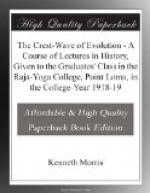“Kai-Kobad the great and Kai-Khusru,”
—all three strong kings and conquerors. When Chosroes II was killed in 628, after a war with Heraclius that began brilliantly and ended in disaster,—the empire practically fell: split up under several pretenders, to be an easy prey for the Moslems a few years later. Was the whole Sassanian period divisible into a day, a night, and a day? Information is not at hand whereby one might gauge the life of the people, and say. The last thirteen decades, certainly, seem to have left their mark as an age of glory on the Persian imagination, and to have been remembered as such in the days of Omar Khayyam.—And here we must leave the Sassanians, having other fish to fry.
We saw the Crest-Wave strike Rome (at Nerva’s accession) in 96; then, 131 years later, raise up Ardashir and Persia in 227; —and so, I suppose, should incline to look east again, and jump another thirteen decades, and land in India, in 357 or thereabouts,—praying God to keep us from a bad fall. India I allow; but look before you leap;—or, if you will, in mid-air turn over in your minds the old Indian cycles, as far as you know them, and see if they offer you any prospect of a landing-place. As thus: there were the Mauryas, 320 to 190 B. C.; thence on thirteen decades to 60 B.C.,—and near enough to the reputed 58 of the reputed Vikramaditya of Ujjain. On again (thirteen decades as usual) to the seventies A.D.—and good enough in all conscience for that slippery Kanishka who so dodges in and out among the early centuries, and is fitted with a new date by everyone who has to do with him. On again, from 70 to 200; nothing doing there, I regret to say, (that we know about). Never mind; on thence to 320,—the nearest point to our 357; let us land in the three-twenties then, and see what happens.
On solid ground: for India, remarkably solid. There actually was a Golden Age there at that time; and everybody seems to agree that it lasted, say, one hundred and twenty-nine years; from 326 to 455. This you will note, was the period of the last phase of the Roman Empire: that of its rapid decline. In 323 Constantine came to the throne, and began making Chrisitianity the state religion; in 330 he moved his capital. After 456, no emperor ruled in the west but for puppets set up by the German Ricimer, two set up by Constantinople, and Romulus Augustulus, the last,—and all within twenty years. There is no bright spot within the whole thirteen decades, except the two years of Julian. The faucet was turned on in India; and the Roman garden went waterless, and wilted.




